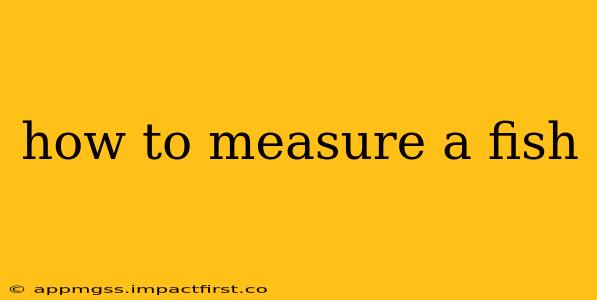Measuring a fish accurately is crucial for various reasons, from complying with fishing regulations to contributing valuable data for fisheries management and scientific research. Whether you're a seasoned angler or a curious beginner, understanding the proper techniques for measuring fish is essential. This guide will cover the different methods and considerations for accurate fish measurement.
What are the Different Ways to Measure a Fish?
There are primarily two methods used to measure fish: total length and fork length. The method used depends on the species and the purpose of the measurement.
Total Length
Total length is the most common method and is measured from the most anterior point of the fish's snout to the end of its longest caudal fin ray (tail fin). This method is straightforward and generally preferred for its simplicity. However, it can be less precise for fish with damaged or irregularly shaped fins.
Fork Length
Fork length is measured from the most anterior point of the snout to the fork of the caudal fin—the point where the tail fin splits into two lobes. This measurement is often preferred for certain fish species, particularly those with long, filamentous fins, as it minimizes the variability introduced by damaged or extended fins. It's frequently used in scientific studies for consistency.
How to Measure a Fish Accurately: A Step-by-Step Guide
Regardless of the method you choose (total length or fork length), follow these steps for accurate measurement:
-
Use the right tool: A flexible measuring tape, preferably with clear markings in centimeters or inches, is essential. Hard measuring boards can be used but are less practical for measuring fish in the field.
-
Prepare the fish: Gently hold the fish, ensuring its body is straight and not bent or curved. Avoid applying excessive pressure that could damage the fish. If possible, measure on a flat surface.
-
Position the measuring tape: For total length, align the zero mark of the measuring tape with the most anterior point of the snout. Extend the tape along the body to the end of the longest caudal fin ray. For fork length, measure to the fork of the caudal fin.
-
Read the measurement: Carefully read the measurement from the measuring tape. Record the measurement to the nearest millimeter or quarter-inch, depending on the required precision.
-
Handle with care: Once measured, handle the fish gently and return it to the water as quickly as possible, ensuring its survival.
What is the Importance of Accurate Fish Measurement?
Accurate fish measurement is crucial for several reasons:
-
Fishing regulations: Many fisheries have size limits to protect younger fish and maintain healthy populations. Accurate measurements ensure compliance with these regulations.
-
Scientific research: Fish length is a crucial metric in fisheries science, used to assess population dynamics, growth rates, and the overall health of fish stocks.
-
Conservation efforts: Accurate data on fish size aids in conservation planning and management decisions.
-
Personal records: Anglers often like to keep track of their catches, and accurate measurements provide valuable data for personal records and comparisons.
How to Measure a Fish Without a Measuring Tape?
While a measuring tape is the most accurate tool, you can improvise in an emergency. This isn't recommended for official reporting or scientific purposes but might be helpful for a quick estimate:
-
Use a ruler or other straight object of known length: Compare the fish’s length to the known length of the object. This method is inherently less precise.
-
Use your hand as a reference: While inaccurate, it can give a rough estimate if combined with a known hand measurement.
What is the Best Way to Measure Different Types of Fish?
The best method depends on the fish's morphology. For fish with long, delicate tails, fork length is preferable. For robust species with less fragile tails, total length is usually adequate. Always strive for consistency in your method for comparative purposes.
This comprehensive guide provides a clear understanding of how to measure a fish effectively. Remember, accurate measurements are essential for responsible fishing, scientific research, and effective conservation efforts.
